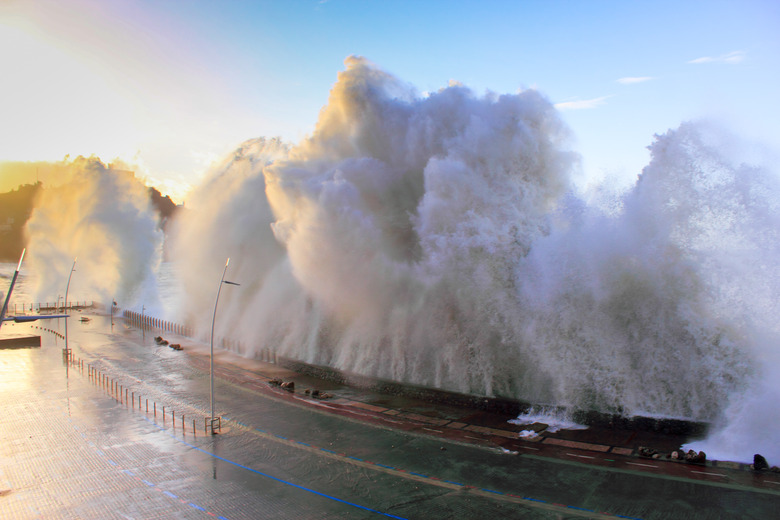What Damage Do Tsunamis Cause?
The Japanese word "tsunami" means "big wave," and it's the preferred way to refer to the phenomena that used to be known as tidal waves. Tsunamis don't have much to do with ocean tides — they are created by seismic events, such as earthquakes and landslides on the ocean floor. When it comes ashore, a tsunami creates a physical catastrophe, and in its aftermath it leaves environmental and health problems that are equally destructive.
TL;DR (Too Long; Didn't Read)
The force of a tsunami causes massive damage and loss of life. And the push of saltwater into freshwater sources nearby can disrupt farming. Flooding can also carry sewage and toxic substances around an environment, posing a health risk.
A Wave of Destruction
A Wave of Destruction
Many tsunamis are too small to notice, but some can have a leading wave as tall as 30 meters or more. As powerful as a wave this size is, however, it's the mass of water behind it that is responsible for most of the physical destruction. The wave crashes against objects near the shore and destroys them, but the water behind it can move much farther inland, lifting buildings off their foundations and creating a swirling pool of debris.
Loss of Life
Loss of Life
The Centers for Disease Control and Prevention reports that the bulk of deaths that result from a tsunami are drownings, but, due to the destruction of public health and sanitation infrastructure, health conditions deteriorate so badly when the tsunami recedes that many more people die in the days after the event. Adverse conditions include contaminated water and food supplies, lack of shelter and lack of access for medical personnel. Diseases can spread rapidly, and minor infections can quickly turn into major ones. People who can't leave the area quickly enough can die of exposure if they can't find shelter.
Environmental Impact
Environmental Impact
A tsunami fills fresh water sources, such as streams, lakes, aquifers and reservoirs with saltwater while also contaminating the soil. Salt inhibits plant growth and can render farmland sterile for several years. The entire contents of commercial and industrial buildings can be washed out by the mass of water, and as a result, chemicals can get mixed together in dangerous combinations and may be washed out to sea or deposited on the ground. This mix includes raw sewage, which adds to the potential for disease. The rush of water can also undermine cliffs, hills and raised roadways that don't crumble immediately but become unstable and dangerous.
The 2011 Tohoku Earthquake and Tsunami
The 2011 Tohoku Earthquake and Tsunami
The 2011 tsunami in Japan created an exceptional environmental hazard by wiping out four reactors at the Fukushima nuclear facility. The event contaminated an area almost as large as the state of Connecticut with radiation, forcing mass long-term evacuations. This tsunami, caused by a massive earthquake that measured 9.0 on the Richter scale, reached a maximum height of 40.5 meters (133 feet), traveled as much as 10 kilometers (6.2 miles) inland and was responsible for 20,000 deaths, as well as the widespread release of radiation. The reactor cooling systems apparently functioned normally during the event, but the facility's protective seawall was too low to shield the backup generators from the advancing wave.
References
- American Association for the Advancement of Science: Underwater Landslide May Have Doubled 2011 Japanese Tsunami
- SMS Tsunami Warning: Tsunamis: the Effects
- Physicians for Social Responsibility: Costs and Consequences of the Fukushima Daiichi Disaster
- SMS Tsunami Warning: Tsunami Japan 2011, Miyagi Prefecture
- Centers for Disease Control and Prevention: Health Effects of Tsunamis
Cite This Article
MLA
Deziel, Chris. "What Damage Do Tsunamis Cause?" sciencing.com, https://www.sciencing.com/damages-do-tsunamis-cause-7551542/. 24 April 2018.
APA
Deziel, Chris. (2018, April 24). What Damage Do Tsunamis Cause?. sciencing.com. Retrieved from https://www.sciencing.com/damages-do-tsunamis-cause-7551542/
Chicago
Deziel, Chris. What Damage Do Tsunamis Cause? last modified March 24, 2022. https://www.sciencing.com/damages-do-tsunamis-cause-7551542/
